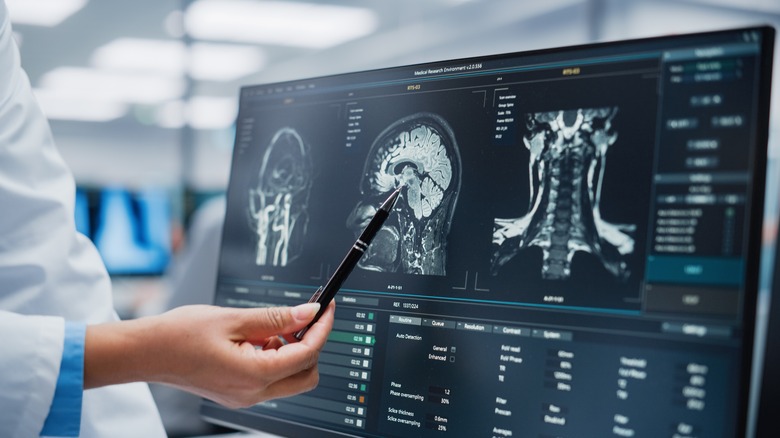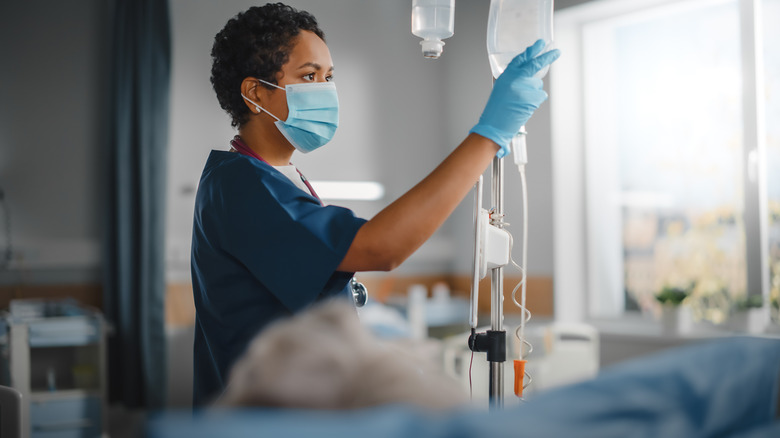What You Need To Know About Cavernous Sinus Thrombosis
Cavernous sinus thrombosis (CST) is a serious condition that occurs when a blood clot forms in the cavernous sinus, a large vein in the brain (via WebMD). The cavernous sinus drains blood from the brain and surrounding structures. When a clot forms, it can block the flow of blood and cause swelling and pressure in the brain. CST is a medical emergency that requires prompt treatment to prevent permanent damage to the brain.
The symptoms of CST depend on how severe the clot is and how quickly it forms. In some cases, people may only have a headache. Other people may experience a sudden onset of dizziness, nausea, and vomiting. They may also develop a fever and weakness on one side of the body. If the clot is large enough, it can block blood flow completely and cause a stroke, which is a medical emergency that occurs when blood flow is blocked to the brain (via Mayo Clinic). A stroke can result in a variety of negative effects including paralysis, loss of speech, and even death. The earlier a stroke is treated, the less likely someone is to die or have permanent brain damage from it.
Causes and Diagnosis
Cavernous sinus thrombosis (CST) can be caused by an infection, injury, or surgery. It is most commonly caused by a bacterial infection of the sinuses, ears, or teeth, which then spreads to the brain (via the National Health Service). Most cases of CST involve the staphylococcal (staph) bacteria, which can also cause sinusitis and boils. Sinusitis is a common cold that lasts for more than a week and is characterized by a runny nose, congestion, and facial pain. Boils are skin infections that occur when bacteria enter through a cut or break in the skin.
CST can also be caused by an injury to the head or face, surgery near the cavernous sinus, or a tumor in the brain. In some cases, the exact cause of CST is unknown. CST is diagnosed with a physical exam and imaging tests. A physical exam will be conducted to look for signs of infection, such as redness, swelling, and tenderness. Imaging tests, such as a CT scan or MRI, will be conducted to look for the clot and any damage it has caused (via WebMD). Sometimes blood or spinal fluid will also be tested for bacteria in order to confirm a diagnosis.
Treatment and Complications
CST is a medical emergency that requires prompt treatment. The main treatment for cavernous sinus thrombosis is antibiotics, which are used to kill the bacteria causing the infection (via the National Health Service). Most people will need to take antibiotics for several weeks to make sure that the bacteria has been effectively removed from the body. When taking antibiotics, it is important to take the full dosage, even if you begin feeling better. If you stop taking them too soon, the bacteria may continue to grow in your body and make you sick again (via Mayo Clinic).
Anticoagulant medications are also used to prevent the clot from getting larger and to help dissolve it. Surgery may also be necessary to remove the clot or drain the infection. If the CST is caused by an injury or surgery, you may also need pain medication and/or surgical treatment. Complications of cavernous sinus thrombosis can include stroke, brain damage, and death. A stroke can cause many complications of its own, including paralysis, loss of speech, and other impairments. The quicker treatment begins, the more likely someone is to make a full recovery from CST.
What to know about stroke
Cavernous sinus thrombosis (CST) is a type of stroke, so it shares many of the symptoms and complications. A stroke occurs when blood flow to the brain is blocked, which can happen if a clot forms in one of the veins that drains blood from the brain (via Mayo Clinic). This blockage can cause a variety of symptoms, including sudden onset of severe headaches, dizziness, nausea, and vomiting. If someone is having a stroke, they may have trouble speaking or understanding others, and they may have weakness or paralysis on one side of their body.
A stroke can also cause paralysis, loss of speech, brain damage, and even death. The sooner treatment begins, the better the chances are for a full recovery. If you believe you or someone you know is having a stroke, it is important to seek treatment immediately. You should follow the FAST rule: face, arms, speech, and time. Look at the person's face and see if one side is drooping. Ask them to raise their arms and see if they are drooping or unstable. Ask them to say a simple sentence and pay attention to how slurred their speech is. And finally, remember that time is of the essence. Call 911 immediately if you believe they are having a stroke.
What to know about blood clots
Cavernous sinus thrombosis occurs when a blood clot forms in the cavernous sinus vein in the brain. Blood clots can happen all over the body and occur when the blood thickens and clumps together (via Cleveland Clinic). While clots are normal, they become a problem when they do not dissolve on their own, which can block blood flow and oxygen to the surrounding tissues. Blood clots can be caused by a variety of things, including injuries, surgery, pregnancy, and certain medical conditions. Treatment for blood clots typically involves anticoagulant medications that thin the blood and prevent clotting. In some cases, surgery may be necessary to remove the clot.
Blood clots that form in the arteries (arterial clots) or veins (venous clots) are the most serious and can cause complications when left untreated. Complications of these blood clots can include stroke, heart attack, and death. Therefore, it is important to seek treatment as soon as possible if you think you may have a blood clot. If you are experiencing symptoms like severe headaches, dizziness, weakness on one side of your body, or severe pain in one area of your body, call 911 immediately.
Life after cavernous sinus thrombosis
If you have been diagnosed with cavernous sinus thrombosis, it is important to follow your treatment plan and take all of your medications as prescribed. You should also attend all of your follow-up appointments and get any recommended vaccinations to prevent infections (via Cleveland Clinic). It is also important to manage any underlying medical conditions that may have contributed to the development of CST. These measures will help reduce your risk of developing CST again in the future.
After you have recovered from CST, you may be at a higher risk for developing blood clots in the future. Therefore, it is important to talk to your doctor about ways to reduce your risk, such as taking anticoagulant medications or avoiding certain activities that could put you at risk for developing a blood clot. You should also make lifestyle changes to help reduce your risk, such as quitting smoking, maintaining a healthy weight, and exercising regularly. By taking these measures, you can help reduce your risk of having another stroke or developing other serious complications.






